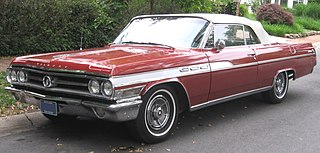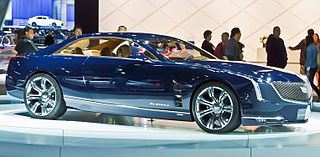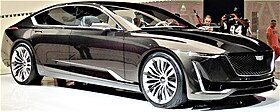
The Cadillac Motor Car Division is a division of the American automobile manufacturer General Motors (GM) that designs and builds luxury vehicles. Its major markets are the United States, Canada and China. Cadillac models are distributed in 34 additional markets worldwide. Historically, Cadillac automobiles were at the top of the luxury field within the United States, but have been outsold by European luxury brands including BMW and Mercedes since the 2000s. In 2019, Cadillac sold 390,458 vehicles worldwide, a record for the brand.

The Chevrolet Bel Air is a full-size car produced by Chevrolet for the 1950–1981 model years. Initially, only the two-door hardtops in the Chevrolet model range were designated with the Bel Air name from 1950 to 1952. With the 1953 model year, the Bel Air name was changed from a designation for a unique body shape to a premium level of trim applied across a number of body styles. The Bel Air continued with various other trim level designations, and it had gone from a mid-level trim car to a budget fleet sedan when U.S. production ceased in 1975. Production continued in Canada, for its home market only, through the 1981 model year.

The Cadillac Eldorado is a luxury car manufactured and marketed by Cadillac from 1952 until 2002 over twelve generations.

The Buick Riviera is a personal luxury car that was marketed by Buick from 1963 to 1999, with the exception of the 1994 model year.

The Buick Electra is a full-size luxury car manufactured and marketed by Buick from 1959 to 1990, over six generations. Introduced as the replacement for the Roadmaster lines, the Electra served as the flagship Buick sedan line through its entire production and was offered as a six-passenger four-door sedan with two-door sedan, two-door convertible, and five-door station wagon variants.

The Cadillac CTS is a luxury car that was manufactured and marketed by General Motors from 2003 until 2019 across three generations. Historically, it was priced similarly to cars on the compact luxury spectrum; but it has always been sized closely to its mid-size rivals. The third generation competes directly with the mid-size luxury cars. Initially available only as a 4-door sedan on the GM Sigma platform, GM had offered the second generation CTS in three body styles: 4-door sedan, 2-door coupe, and 5-door sport wagon also using the Sigma platform — and the third generation was offered only as a sedan, using a stretched version of the GM Alpha platform.

The Chevrolet Malibu is a mid-size car manufactured and marketed by Chevrolet from 1964 to 1983 and again since 1997. The Malibu began as a trim-level of the Chevrolet Chevelle, becoming its own model line in 1978. Originally a rear-wheel drive intermediate, GM revived the Malibu nameplate as a front-wheel-drive car in 1997.

The Buick Roadmaster is an automobile that was built by Buick from 1936 until 1942, from 1946 until 1958, and then again from 1991 until 1996. Roadmasters produced between 1936 and 1958 were built on Buick's longest non-limousine wheelbase and shared their basic structure with the entry-level Cadillac Series 65, the Buick Limited, and after 1940, the Oldsmobile 98. Between 1946 and 1957 the Roadmaster served as Buick's flagship.

The Buick LeSabre is a full-size car made by the division Buick of General Motors from 1959 until 2005. Prior to 1959, this position had been retained by the full-size Buick Special model (1936–58). The "LeSabre", which is French for "the sabre", was Buick's mid-level full-size sedan above the Special but below the Electra during the 1960s then remained in its market position when the Electra was replaced with the Park Avenue. The LeSabre was available as a 2-door convertible, sedan or hardtop, a 4-door sedan or hardtop and station wagon throughout its production.

The Buick Wildcat is a full-size car that was produced by Buick from the 1963 to 1970 model years. Taking its name from a series of 1950s Buick concept cars, the Wildcat replaced the Invicta within the "junior" B-body Buick sedan range. Serving as the higher-performance full-size Buick, the Wildcat was slotted between the LeSabre and the larger C-body Electra.

The Cadillac Sixty Special is a name used by Cadillac to denote a special model since the 1938 Harley Earl–Bill Mitchell–designed extended wheelbase derivative of the Series 60, often referred to as the Fleetwood Sixty Special. The Sixty Special designation was reserved for some of Cadillac's most luxurious vehicles. It was offered as a four-door sedan and briefly as a four-door hardtop. This exclusivity was reflected in the introduction of the exclusive Fleetwood Sixty Special Brougham d'Elegance in 1973 and the Fleetwood Sixty Special Brougham Talisman in 1974, and it was offered as one trim package below the Series 70 limousine. The Sixty Special name was temporarily retired in 1976 but returned again in 1987 and continued through 1993.

The Cadillac Series 70 is a full-size V8-powered series of cars that were produced by Cadillac from the 1930s to the 1980s. It replaced the 1935 355E as the company's mainstream car just as the much less expensive Series 60 was introduced. The Series 72 and 67 were similar to the Series 75 but the 72 and 67 were produced on a slightly shorter and longer wheelbase respectively. The Series 72 was only produced in 1940 and the Series 67 was only produced in 1941 and 1942. For much of the postwar era, it was the top-of-the-line Cadillac, and was Cadillac's factory-built limousine offering.

The Cadillac Sixteen is a concept car first developed and presented by Cadillac in 2003.

The Cadillac Ciel is a hybrid electric concept car created by Cadillac and unveiled at the 2011 Pebble Beach Concours d'Elegance. The Ciel has a twin-turbocharged 3.6-liter direct injection V6 producing 425 hp (317 kW) and a hybrid system using lithium-ion battery technology. The Ciel is a four-seat convertible with a wheelbase of 125 inches (3,200 mm). It was developed at GM Design's North Hollywood Design Center.

The Cadillac Elmiraj is a concept car created by Cadillac and unveiled at the 2013 Pebble Beach Concours d'Elegance on August 15, 2013. It continues the development begun by the Cadillac Ciel concept car. It was named for the Elmira, New York, though some claim it's a dry lake bed that was used for high speed runs.

The Buick Avenir is a concept car manufactured by Buick. The name of the vehicle Avenir means 'future' in French. In October 2017, Buick made Avenir a premium top-of-the-line sub-brand, similar to GMC’s Denali and Chevrolet’s Signature series. The Buick LaCrosse and Enclave were the first vehicles to receive this upgrade for the 2018 model year.

The Cadillac CT6 is a full-size luxury car manufactured by Cadillac since 2016 over two generations. The first generation CT6 was introduced at the 2015 New York International Auto Show and went on sale in the U.S. in March 2016. It is the first car to adopt the brand's revised naming strategy, as well as the first rear-wheel drive full-size Cadillac sedan since the Fleetwood was discontinued in 1996.

The Buick Avista is a concept 2-door, 2+2-seater hardtop coupe built by Buick, first unveiled at the 2016 North American International Auto Show on January 10, 2016.
The Cadillac Blackwing V8 is a twin-turbo DOHC V8 engine that was produced by the Cadillac Division of General Motors for use in its CT6-V between 2018 and early 2020. It is a clean sheet engine design, as well as the Division's first ever twin-turbo V8 engine. The engine was branded as the "Blackwing V8" by GM technicians, and is the first Cadillac-exclusive dual overhead cam V8 engine since the Northstar V8 was dropped in 2011.
The Cadillac Celestiq is an electric car made by General Motors' Cadillac division. Expected to begin sales for the 2024 model year.


















